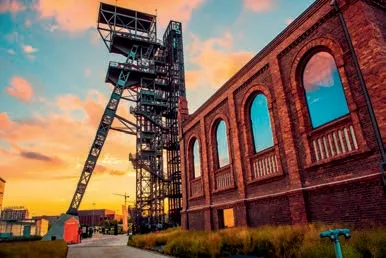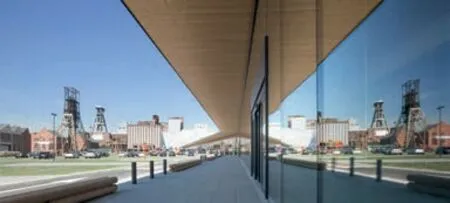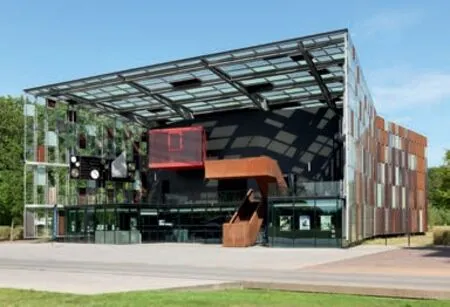欧洲矿业经历与为转型而设计
卡罗拉·S·诺伊格鲍尔,安娜·玛利克·韦伯,克里斯塔·莱歇尔/Carola S. Neugebauer, Anna Marijke Weber, Christa Reicher陈茜 译/Translated by CHEN Xi
1 矿业经历
自中世纪早期以来,采矿业及其扩张、技术发展与衰败的各个阶段深刻塑造了欧洲的空间与人。德国的厄尔士山脉就令人回想起这段悠久历史及其遗产。2019 年7 月被评定为联合国教科文组织世界遗产,代表厄尔士的早期矿石开采的及其多元化影响价值得到了认可。12 世纪中叶起,人们开始对银、锡、铜、铁等金属进行开采,15 世纪采矿业的扩张,不仅带来了“前资本主义的经济融资体系”和“用于深井开采的新技术与其他创新”[1]7,同时也诞生了一批矿工定居点和城镇。基督教信仰深刻锚固于矿工们的思想意识中,宗教传统反过来也成为了采矿的精神符号。由于采矿业的起起伏伏,经济发展的替代性分支产业获得发展,16 世纪时兴起了如纺织品、玻璃、纸张、钟表等手工制造业以及木工行业(玩具制造),到19 世纪则迎来了汽车工程、机械工程与工具工业[1]8。大学的建立与这些发展紧密相关[2]。在德国戈斯拉尔的哈茨山区、俄罗斯的乌拉尔山脉、瑞典的法伦、英国的德文郡和康沃尔及斯洛伐克的班斯卡什佳夫尼察,前现代矿业开采的历史也以与之类似又各具特色的方式塑造了当地的人与空间。
工业化将采矿业带向鼎盛时期。鲁尔地区的硬煤开采就是其中的代表。在19 世纪,铁路的建造和蒸汽机的使用,令鲁尔河实现了通航,奠定了该地区进行高度工业化采矿的基础,因而使得工业化的深井采煤成为可能。区域内的中世纪城市也蜕变成为工业城市,并经历了几次国际移民浪潮。20 世纪上半叶硬煤开采的扩张的同时,化学工业、国防工业以及电力行业等新兴产业相伴发展。高度工业化的煤炭和钢铁产业集群令所在地区遭到了严重的环境破坏(大量的空气和水污染),这样的变化也引发了外部对整个区域的负面看法。在波兰的西里西亚和乌克兰的顿巴斯等欧洲城市,当时的硬煤开采强度与鲁尔区无异。法国的北部加来海峡地区,作为煤炭开采的早期工业重地,如今也成为了联合国教科文组织世界遗产地。
露天褐煤开采是欧洲高度工业化采矿的另一种形式。在德国,它已在卢萨蒂亚、莱茵河流域、德国中部和黑尔姆施泰特等地区运营了150 年。由于其景观消耗的特征,只有在欧洲的农村地区才可能进行,这样可以使得因露天采矿而进行的居民迁移相对较少。
以上这几例历史的关键时刻,刻画出矿业遗迹地的高度多样化。欧洲的采矿业随资源、技术和历史时期而呈现出不同的面貌。这包含了物质层面及非物质层面的多种元素——如矿井与矿山,采矿技术设备与相关贸易,定居点与景观以及被采矿业塑造并强化的手工艺、美术、音乐、文学、语言和宗教实践的传统。此外,上述案例均揭示了采矿这一产业在各地区及当地居民的经济、社会文化与生态发展之间创造的紧密且复杂的关联。采矿并非纯粹的单领域经济活动,也是景观和环境资源、聚居点居民及其日常生活、知识与文化的构成要素。
2 后矿业挑战
几个世纪以来,当地居民多是自发地不断适应着采矿产业的衰败所带来的后果。矿厂关闭后,他们转移到相关的工业产业,多多少少算是成功进入了替代经济领域的发展,还有一些移民到其他地方。大自然重新夺回了对废弃采矿地的主权。只有在20 世纪下半叶,工业化开采对空间和社会产生严重而深刻的影响之时,对后矿业多层次遗留后果的敏感程度才有所增加。如何应对其基础影响的批判性思考开始发展,对“设计”后矿业未来的呼吁开始涌现——努力在社会、经济和环境上都实现可持续的、整合的且平衡的转型。大规模的后矿业转型需要在空间层次进行设计吗?我们如何才能实现这一目标?这样的问题成为了话题的核心。
时至今日,该问题的重要性仍难以摘除。一方面,世界各地包括欧洲在内的开采活动与未来矿业规划仍然继续进行着。相关地区及其居民终归将面临后矿业转型的挑战,并努力实现最佳结果。另一方面,现今我们已然见证了上面提到的德国4 个褐煤开采区中最终面对后矿业时代的“设计”时那些具体而严峻的挑战。鉴于全球范围内不断增长的环境保护和气候变化意识,对化石燃料和褐煤开采的反对日益加剧,德国政府于2019 年1 月宣布,到2038 年将完全取消褐煤开采。这一决定在实际上宣告了德国大规模采矿业的结束。至少400 亿欧元的国家资金被承诺用于支持露天采矿地区的基础转型的过程。
3 为后矿业空间转型而设计
在此背景下,我们亟需围绕为空间与人“设计”后矿业可持续转变的有效方法而进行反思与探讨。本期专辑为此提供了良好的契机,故在汇编过程中我们特别坚持了以下两点原则:一,通过设计项目的比较展开以推动学习借鉴;二,借此提升对本土后矿业设计与地域化转型方法的依赖性关联意识。
1 Experiences of mining
Mining and its phases of expansion,technological development and decline have shaped spaces and people in Europe since the early middle ages. The Ore Mountains (Erzgebirge) in Germany reminds of this long history and heritage. The UNESCO world heritage region since July 2019 stands for the early ore mining and its various impacts. In the middle of the 12th century the mining of silver, tin, copper and iron started and its expansion in the 15th century brought about not only "pre-capitalistic economic systems of financing"and "new technologies for deep mining and other innovations"[1]7, but also mining settlements and towns. The Christian religion was anchored in the miners' consciousness and religious traditions took up symbols of mining in turn. As a result of the ups and downs in mining, alternative branches of the economy developed like the manufacturing of textiles, glass, paper, watches and the woodworking trades (toy manufacture) since the 16th century, and automotive engineering, mechanical engineering and the tool industry in the 19th century[1]8.University foundations were closely related to these developments[2]. In a similar and yet specific way, premodern ore mining was also shaped by people and spaces in the Harz region (Gosslar, Germany), the Ural Mountains (Russia), Falun in Sweden, Devon and Cornwall (England) or in Banská Štiavnica(Slovakia).
Industrialisation brought a heyday to mining.Hard coal mining in the Ruhr region is an example of this. Here, in the 19th century, the foundations for highly industrial mining were laid by making the river Ruhr navigable, by constructing railways and by using steam engines, which made industrial deep coal mining possible. The medieval cities of the region grew into industrial cities and experienced several waves of international immigration. The expansion of hard coal mining in the first half of the 20th century was accompanied by new industries such as the chemical and defense industries and electricity generation. The highly industrialised coal and steel cluster shaped the region through severe environmental damages (massive air and water pollution) and was accompanied by a negative external perception of the whole region. Hard coal was mined at similar intensities in Europe in Silesia (Poland) and in Donbas (Ukraine). An early industrial focal point of coal mining was the region of Nord-Pas de Calais, also with UNESCO world heritage sites.
Lignite mining as opencast technique is another form of highly industrialised mining in Europe. In Germany, it has been operated for 150 years in the Lusatian, Rhine, Central German and Helmstedt districts. With its landscape-consuming character,it is possible above all in rural regions in Europe,where it means the resettlement for comparatively few people.
These few highlights of history underline the great variety of mining heritage. Mining in Europe differs according to the resource, technique and historic period of mining. It comprises material as well as immaterial layers, e.g. pits and mines,technical facilities of mining and accompanying businesses, settlements and landscapes as well as traditions of craftsmanship and religion, art, music,literature and language shaped and consolidated by mining. Moreover, the examples above underline the tight and complex connections that mining creates between the economic, socio-cultural and ecological development of the regions and their people. Mining is not a sectoral economic activity, but formative for the landscape and environmental resources, for settlements and people with their everyday lives,knowledge and culture.
2 Challenges of post-mining
Over centuries, local people mainly selfarranged with and adapted to the consequences of mining downs. When mines closed down, they shifted to adjacent industries, developed more or less successfully alternative economic spheres or emigrated to other places. The nature recaptured abandoned sites of mining. Only in the second half of the 20th century, when the industrialised mining affected harshly and deeply on spaces and society,the sensitivity to the multi-layered consequences of post-mining grew. Critical thinking developed how to cope with the fundamental impacts and calls emerged to "design" the post-mining future,striving for sustainable, integrated and balanced transformations within society, economy and environment. One question became central: How can, and do we design the great post-mining transformation in space?
This question is of unbroken relevance till today. On the one hand, there are continuing mining activities and future planning for mining worldwide and including Europe. One day, the concerned regions and people will face the challenges of postmining transition and strive at making the best out of it. On the other hand, we witness already today the concrete and large-scale challenge to "design"the post-mining era in the last, four lignite mining districts in Germany, mentioned above. In line with the worldwide growing awareness for environmental protection and climate change, which turns also against fossil fuels and lignite mining, the German government declared in January 2019 to withdraw from lignite mining by 2038. The decision ends large-scale mining in Germany in general. At least 40 billion euros of state funding is promised to support the fundamental transformation processes in the opencast-mining regions.
3 Designs for post-mining transformation
Against this background, reflections and discussions on promising approaches to "design"sustainable post-mining transitions in space and for people are highly needed. This theme issue constitutes a great opportunity to do so and we thus pursued in particular two rationales when compiling the issue: firstly, to encourage learning by comparing projects of design; secondly, to sensitise for the interdependency of local post-mining designs and regional approaches to transformation.
3.1 Comparing post-mining designs
Europe shows many and manifold projects dedicated to the revitalisation, reuse and reinterpretation of former mining sites. Enabling the comparison of contrasting as well as similar design projects is the important precondition to learn from this variety. The issue thus displays a broad array of scales, functional programmes, disciplinary approaches, esthetics and local contexts of postmining designs in Europe.
3.1 后矿业设计比较
关于前矿业地区的复兴、再利用和重译,欧洲已有丰富多样的项目案例。提供对类似设计项目进行比较和对比的可能性条件是从案例多样性中汲取经验的重要前提。因此,本期专辑收录展示了无论在尺度范围、功能组成、学科方法、审美视角还是所在语境都呈现出广泛差异的欧洲后矿业设计。
例如,西里西亚卡托维兹(图1,见70 页)、埃森和盖尔森基兴的案例展示了独栋采矿大厦的再设计。建筑适应了新的功能需求,向今昔展示着过去的采矿历史文化(借助博物馆的形式,如鲁尔博物馆,见46 页),承载新的经济活动(如原北极星煤矿的现代化办公楼,见56 页;贝灵恩be-MINE的休闲设施和购物中心,图2,见26 页),成为教育基地或新的文化引擎(如盖尔森基兴的音乐排练中心或瓦尼的“矿坑9 号乙”,图3、4)。
贝尔瓦尔、基律纳和鲁尔地区的例子补充说明了社区和景观的尺度。它们佐证了功能植入的多样性,如服务于居住、商业、娱乐和科学等,但特别凸显了规划与艺术多学科的富有成效的相互作用。原北极星煤矿开采点和申格尔贝格工人定居点(图5,见52 页)的案例,将建筑、城市设计、景观与艺术做了很好的整合。
所有地方化的后矿业设计都主要是通过提出新的适应性使用方式来发掘和重新增加当地的宜居性,并在创造具有吸引力的全新开放空间的同时,修复采矿造成的环境破坏。如此一来,这些项目往往凭借中长期的规划展现出转型的动力:通过提出新的想法和为这些地点创造新的身份与正面认知,许多项目成功推动了经济、社会文化和生态在短期效果基础上的进一步转变。案例比较显示出,欧洲的众多后矿业设计不仅仅是大规模的针对性设计,而且是累积式的增量项目,其发展演化可以基于各方参与者和建筑师的专业操作而持续数十年。
设计思想与创新总是随着时间的推移不断被重塑以适应现状。雨果和哈塞尔煤矿的案例(见阿克塞尔·廷佩的文章,见38 页)很好地展示了这一点。彼得·拉茨在1990 年代为北杜伊斯堡景观公园(见60 页)提出的“工业自然”概念,直到今天仍然启发着后矿业公园的设计,并逐渐演变为了新的“工业化自然”的新理念:后煤矿公园成为一个再生能源的公园,从而回应了长期的宜居性提升需求和当前的资源保护的需求。
对遗迹地历史和遗产的强烈参照是欧洲后矿业设计的另一个特征。安娜·玛利克·韦伯在她的论文《多面性——建筑转型的工具》(见14 页)中更为详尽地研究了这一点。通过对一些后矿业建筑设计的比较,她阐明了设计如何处理物质性与非物质性,如何处理真实的与关联的后矿业地点遗产。她揭示了这些设计的相似性和差异性,从而指向了既有独特性和创新性的张力,也有效仿可转移性原则的结论。安娜的供稿明确指出了比较研究作为产出新知识和促进相互学习的一种策略而具有的价值。这可能会激发对上述某些观察结果更详细探讨的进一步研究,例如,后矿业设计如何以及为何展现(或没有)当地的转型动力。
3.2 反思后矿业转型中地方设计与区域方法的连结
库恩、索洛宁娜、和哈伊杜加等作者在本期中的供稿回顾了后矿业转型区域的尺度,引发对欧洲一些规模最大的(后)矿业区域的关注。然而除尺度外,这些文章也指向了对连结的关注,将当地后矿业设计与区域状况及方法联系起来,以应对复杂的后矿业转型。
理想状态下,两个“设计层级”以积极的、支持性的方式相互作用。 区域方法通过诸如在财政上的统筹、指导和支持来实现对当地后矿业设计与各方转化举措的理想嵌合。反过来,如上所述,当地的后矿业设计可以展现转型动力,并影响其邻近地区或更广范围的发展,或作为大众周知的地标(如鲁尔博物馆和北杜伊斯堡景观公园),或作为日常生活中的被珍视与喜爱的去处。
德国鲁尔地区1989-1999 年的埃姆舍尔公园国际建筑展是积极进行地方-区域连结设计的一个好例子。在鲁尔区及其他案例中(参见库恩文章中说明的皮克勒亲王郡国际建筑展,66 页),国际建筑展被印证为一种有价值的战略性规划方法,可以在区域层面上激发和协调当地的后矿业设计,并鼓励国家、社会和经济领域的各色人员投入该区域的转型中。IBA 方法还有助于该区域空间层面转型的总体思路和概念的设计(参见论文《欧洲地区后矿业空间转型的设计方法》,20 页)。
然而,区域和地方后矿业设计之间的互关并非是普适性的。在乌拉尔山脉的案例中(见82 页),这种连结不复存在。由于在区域及更高层级上缺少政治、经济和规划层面的支持和关注,当地的后矿业设计只能退回到自助式操作,回到荒芜与衰败的浪漫主义。更广泛的条件决定了后矿业设计在地方和区域层面的范围、速度和转化影响。在莱歇尔和诺伊格鲍尔的文章(见20 页)中指出,无论是区域层级的IBA 等战略性规划方法,还是地方层级进行的后矿业规划,独自作用都不足以保证成功且可持续的后矿业转型。倒是若干要素与举措的相互作用似乎在欧洲案例中成效卓著。
还有曾出现并不断出现的问题是:这些从欧洲案例中得出的结论在全球语境内具有多高的可靠程度?在中国能够引发进一步相互学习的后矿业经验,包括地方和区域层次的设计是什么?我们希望本期专辑可以吸引读者关注对这些议题展开交流的可能性。□

1 波兰西里西亚省博物馆于2015年在原先的卡托维兹矿井开设了新馆/Muzeum Silesia opened its new seat in the former"Katowice" mine in 2015(图片来源/Source: Industrial Monuments Route)

2 贝灵恩be-mine的休闲设施/Leisure facilities and shopping in Beringen be-MINE

3 矿坑9号乙全貌。除了使历史遗产重新焕发活力之外,该地还需要一个现代化举措,将使该地的新音乐方向更加明确/Overview of Fosse 9-9bis. In addition to the revitalised historical legacy the site needed a contemporary act which would crystallise the site's new music orientation

4 矿坑9号乙Métaphone音乐厅,既是音乐厅又是城市乐器/The Métaphone in Fosse 9-9bis is a concert hall and urban musical instrument(3.4图片来源/Sources: ©Hérault Arnod Architectures)

5 俯瞰申格尔贝格工人定居点/View of the workers' settlement of Schüngelberg
The contributions about Katowice (Fig. 1, page 70), Essen and Gelsenkirchen show, for example,the re-design of single mining edifices. Buildings are adapted to new functions, presenting today the past mining history and culture (e.g. in form of museums like the Ruhr Museum, page 46) and hosting new economic activities (e.g. modern offices on the former Nordstern colliery, page 56; leisure facilities and shopping Beringen be-MINE, Fig. 2, page 26),hotspots for education or new cultural impulses like a music rehearsal centre in Gelsenkirchen or the site of "Fosse 9-9bis" in Oignies (Fig. 3, 4).
The examples of Belval, Kiruna and the Ruhr region address in addition the scale of neighbourhoods and landscapes. They exemplify the diversity of functional programming too (e.g. serving for housing, business, recreation and science), but highlight in particular the fruitful interplay of various planning and artistic disciplines. The former colliery Nordstern and the works settlement of Schüngelberg (Fig. 5, page 52), bringing together architecture, urban design, landscape architecture and art, are examples here.
All the local post-mining designs aim primarily to discover and re-increase local livability by proposing new and adapted uses, and to repair the environmental damages of mining when creating new attractive open spaces. In doing so, the projects often unfold transformative power in a mid- and longterm perspective: Many of them foster successfully the further economic, socio-cultural and ecological transformation of their proximities by giving new ideas, by creating new identities and positive awareness for the sites. The comparison of the examples reveal that many post-mining designs in Europe are not only big ad-hoc designs, but incremental projects, evolving over decades and drawing on the expertise of various actors and architects.
Ideas and innovations in designs are reformed over time and adapted to the present. The example of the colliery Hugo and Hassel (cf. paper of Axel Timpe,page 38) shows that nicely. The concept of "industrial nature", which Peter Latz developed in the 1990s for the landscape park Duisburg-Nord (page 60)with inspirations for post-mining park designs till today, turns here to the new idea of a "industrialised nature": The post-coal mining park becomes a park of re-growing fuels that thus responds to the longstanding need of increased livability and the current demand for resource conservation.
The strong reference to the history and heritage on site is another feature of European postmining designs. Anna Marijke Weber researches this reference in her paper Polyvalence: A Tool for Architectural Transformation (page 14). Comparing several post-mining designs in architecture, she sheds light on how designs deal with the material and immaterial, with authentic and associative legacies of the past mining sites. She reveals similarities and differences of designs and thus point to the tension between the specificity and innovation, on the one hand, and the principle ,imitation, transferability in design, on the other.Anna's contribution points explicitly to the value of comparison as strategy to generate new knowledge and to facilitate mutual learning. It may encourage further research that explores in more detail some of the aforementioned observations, for example,how and why post-mining designs unfold locally transformative power or not.
3.2 Reflecting the nexus of local designs and regional approaches to post-mining transformation
The contributions of Kuhn, Solonina et al.and Hajduga et al. in this issue recall the regional scale of post-mining transformation, when drawing attention to some of the biggest (post) mining regions in Europe. Apart from the scale, however,these contributions point also to the nexus, which links the local post-mining designs with the regional circumstances and approaches to cope with the complex post-mining transformations.
Ideally, both "levels of design" interplay in a positive, supportive manner. Regional approaches ideally embed, e.g. charge, inform or support at least financially and politically local post-mining designs and respective local initiatives for transformation.In turn - and as mentioned above - local postmining designs can unfold transformative power and impact on the development of their close proximities and the broader region, either as widely known icons (e.g. the Ruhr Museum and landscape park Duisburg-Nord) or as valuable and appreciated places of daily life.
One good example for the positive design of the local-regional nexus has been the International Building Exhibition (IBA) Emscher Park in 1989-1999 in Ruhr region of Germany. In the Ruhr region and in other examples (cf. Kuhn: IBA Fürst-Pückler Land, 2000-2010, page 66), the IBA proved to be a valuable strategic planning approach, which can stimulate and coordinate local post-mining designs on a regional level and encourage the commitment for the region of various actors in state, society and economy. The IBA approach can also help to design overall ideas and concepts for the spatial transformation of the region (cf. Approaches to Design Post-mining Transformations in European Regions, page 20).
Yet, the interdependence between regional and local post-mining designs does not work out well everywhere. In the case of the Ural Mountains(page 82), this nexus is missing. Local post-mining designs fall here back to Do-it-Yourself initiatives and the romanticism of wilderness and decay,since political, economic and planning support and interest are lacking at the regional and upper levels. The broader circumstances are thus decisive for the scope, pace and transformative impacts of post-mining designs at the local and regional level.In their contribution, Reicher and Neugebauer point out that neither strategic planning approaches like IBA at the regional level, nor local post-mining planning alone are sufficient to condition successful and sustainable post-mining transitions (page 20). Rather, the interplay of several factors and initiatives seems to be relevant in the European cases.
Some questions, which then and constantly comes up: To what extent do these European conclusions hold true in other global contexts? What are post-mining experiences as well as local and regional designs in China that could trigger further mutual learning? We hope that this thematic issue draws attention to the potential of mutual exchange on these questions.□

